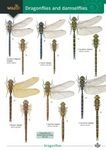![Functional Morphology and Evolution of the Male Secondary Copulatory Apparatus of the Anisoptera (Insecta: Odonata) Functional Morphology and Evolution of the Male Secondary Copulatory Apparatus of the Anisoptera (Insecta: Odonata)]()
Click to have a closer look
About this book
Contents
Customer reviews
Related titles
About this book
Language: English
In this study, the functions and mechanical interactions of different parts of the secondary copulatory apparatus of Anisoptera are reconstructed in detail and possible evolutionary pathways are described. Whereas in Zygoptera and Anisozygoptera the vesica spermalis of the third abdominal segment is a single segmented intermediate sperm-storage, this organ is subdivided into four segments in the Anisoptera. The evolutionary consequences of acquiring new functions as secondary (in reality tertiary) "penis" and sperm-syringe are one focus of this study. The secondary copulatory apparatus of male dragonflies (Odonata), located at the second and third abdominal segment, consists of a number of sequentially arranged devices.
These serve (1) as support of the female ovipositor, (2) for carrying out preparatory actions for filling an intermediate sperm-storage, (3) for levering and inserting a secondary "penis" (in the primitive case the ligula) and (4) as transmitter of sperm to the female vagina. Each subtask affords a sequence of actions of the corresponding sclerites and muscles of this apparatus.
An impressive variety of different solutions to perform and secure the filling of the sperm-reservoir of the vesica spermalis in the Anisoptera is described. In the primitive case a laborious and time-consuming procedure – which probably depends on interrelated functions of the ligula and female ovipositor – is carried out. Reduction of the ovipositor in different lines of the Anisoptera apparently initiated evolutionary modifications, which finally led to more sophisticated modes of preparing filling and protection.
Another focus are the auxiliary devices and techniques in the Anisoptera for emptying the sperm-reservoir of the vesica spermalis. For instance, two different types of sperm-pumps are incorporated in its distal segment ("glans"). These pumps – which extend the function of a hydraulically working gland-structure, the erectile organ – show an opposite co-ordination of sperm-suction and -ejection in connection with compression and decompression movements. It was tried to reconstruct a transitional system to close a serious gap in the phylogenetic interpretation.
A comparative investigation of different 'glans' led to the discovery of different 'ways' of combining the emptying-mechanism of the sperm-reservoir with an intensification of the sperm-jet and a 'washing out' of sperm of the male predecessor (sperm displacement). The different stages of evolution of the glans, which reflect phylogenetic splittings, are outlined and discussed.
This study is of great interest to biologists interested in the functional morphology of the Odonata. It does not merely rely on painstaking comparisons of morphological details, but integrates functional points of view to use the heuristic power of hypothetical approach.
Contents
1. Functional morphology of the skeleton-muscle systems 2
1.1 Introduction 2
1.2 Material and methods 3
Abbreviations 3
1.3 Basic construction and functions 3
1.4 Cordulegastridae 8
1.4.1 Cordulegaster boltonii (Donovan) and
Cordulegaster bidentata Selys 8
1.5 Neopetaliidae 12
1.5.1 Neopetalia punctata (Hagen) 12
1.6 Chlorogomphidae 15
1.6.1 Chlorogomphus brunneus Oguma 15
1.7 “Corduliidae”, Gomphomacromiidae,
Cordulephyidae and Synthemistidae 16
1.7.1 Cordulia aenea (Linnaeus) 16
1.7.2 Macromia splendens (Pictet) 20
1.7.3 Oxygastra curtisii (Dale) 22
1.7.4 Pseudocordulia elliptica Tillyard 24
1.7.5 Gomphomacromia paradoxa Brauer 24
1.7.6 Cordulephya pygmaea Selys and C. bidens
Sjöstedt 24
1.7.7 Choristhemis flavoterminata (Martin) and
Eusynthemis nigra (Tillyard) 26
1.8 Libellulidae 26
1.8.1 Orthetrum cancellatum (Linnaeus),
O. coerulescens (Fabricius) and
Libellula quadrimaculata Linnaeus 26
1.9 Gomphidae 30
1.9.1 Onychogomphus forcipatus (Linnaeus) 30
1.9.2 Gomphus pulchellus Sélys 34
1.9.3 Ictinogomphus ferox (Rambur) 36
1.10 Petaluridae 40
1.10.1 Petalura gigantea Leach 40
1.10.2 Tachopteryx thoreyi Hagen 43
1.11 Gomphaeschnidae 43
1.11.1 Gomphaeschna furcillata Say 43
1.12 Evolution 45
1.12.1 Evolution of basic differences 45
1.12.2 Evaluations concerning efficiency 52
2. The hydraulic apparatus of the vesica spermalis 53
2.1 Introduction 53
2.2 Material and methods 54
Abbreviations 54
2.3 Preliminary remarks 55
2.4 Aeshnidae 56
2.4.1 Boyeria irene (Fonscolombe) 56
2.4.2 Aeshna cyanea (Müller) 61
2.5 Gomphaeschnidae 62
2.5.1 Gomphaeschna furcillata Say 62
2.6 Cordulegastridae 63
2.6.1 Cordulegaster boltonii (Donovan) and
Cordulegaster bidentata Selys 63
2.7 Neopetaliidae and Chlorogomphidae 66
2.7.1 Neopetalia punctata (Hagen) and
Chlorogomphus brunneus Oguma 66
2.8 Petaluridae 70
2.8.1 Petalura gigantea Leach 70
2.8.2 Tachopteryx thoreyi Hagen 71
2.9 Gomphidae 72
2.9.1 Gomphus vulgatissimus (Linnaeus) 72
2.10 Austropetaliidae 72
2.10.1 Archipetalia auriculata Tillyard and
Hypopetalia pestilens McLachlan 72
2.11 Libellulidae 74
2.11.1 Libellula quadrimaculata Linnaeus 74
2.11.2 Orthetrum cancellatum (Linnaeus) 80
2.12 Synthemistidae 82
2.12.1 Choristhemis flavoterminata (Martin) 82
2.12.2 Eusynthemis nigra (Tillyard) 83
2.12.3 Synthemis serendipita Winstanley 84
2.13 Gomphomacromiidae and Cordulephyidae 84
2.13.1 Gomphomacromia paradoxa Brauer 84
2.13.2 Cordulephya pygmaea Selys and
C. bidens Sjöstedt 86
2.14 “Corduliidae” 86
2.14.1 Somatochlora metallica (Vander Linden) 86
2.14.2 Cordulia aenea (Linnaeus) 90
2.14.3 Pseudocordulia elliptica Tillyard 90
2.15 Evolution 90
2.15.1 Evolution of the „two-way tap“ 90
2.15.2 Evolution of the pressure-suction pump 91
2.15.3 Evolution of the suction-pressure pump 93
2.15.4 Evaluations concerning efficiency 97
2.16 Discussion 98
2.16.1. Observations and experimental
difficulties 98
2.16.2 Discrepant hypotheses concerning the
function of the glans 100
3. Phylogenetic conclusions 100
4. Acknowledgements 103
5. References 103
Customer Reviews

















![Die Eiszeitlibellen der Alten Welt: Pleistozäne Biogeographie Paläarktischer Libellen [Ice-Age Odonata of the Old World. The Pleistocene Biogeography of Palearctic Dragonflies]](http://mediacdn.nhbs.com/jackets/jackets_resizer_medium/24/245896.jpg?height=150&width=111)





















